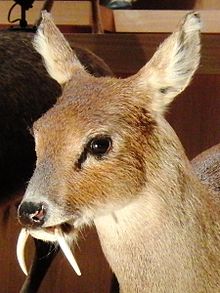Water deer

| Water deer | |
|---|---|
 | |
| Scientific classification | |
| Kingdom: | |
| Class: | |
| Order: | |
| Family: | |
| Genus: | Hydropotes |
| Binomial name | |
| Hydropotes inermis | |

The water deer (Hydropotes inermis) is an even-toed ungulate mammal of the deer family. It is the only member of the subfamily Hydropotinae. There are two subspecies: the Chinese water deer (Hydropotes inermis inermis) and the Korean water deer (Hydropotes inermis argyropus).
Appearance
[change | change source]Water deer are small deer: they are about 90 cm long and about 50 cm high. They weigh about 13 kg. The water deer has yellowish-brown fur, with a white chin and throat. Both males and females do not have antlers. Males have long upper canine teeth (called tusks), which can be up to 5 cm long.
Habitat
[change | change source]The water deer originally lived in China and Korea. Today there are also small wild populations in England and France. Water deer live close to water: in swamps and on the shores of rivers and lakes.
Life
[change | change source]Water deer eat grasses and reeds. They also eat grains and vegetables from fields.
Water deer live alone, but sometimes they form small groups.
After a pregnancy of 200 days the female gives birth to 2-4 babies. A water deer baby has white dots and stripes on its fur, which disappear after 8 weeks. They drink milk for 3 months. When the young water deer are 6 months old they are independent and leave their mothers. They become mature when they are 1 year old.
